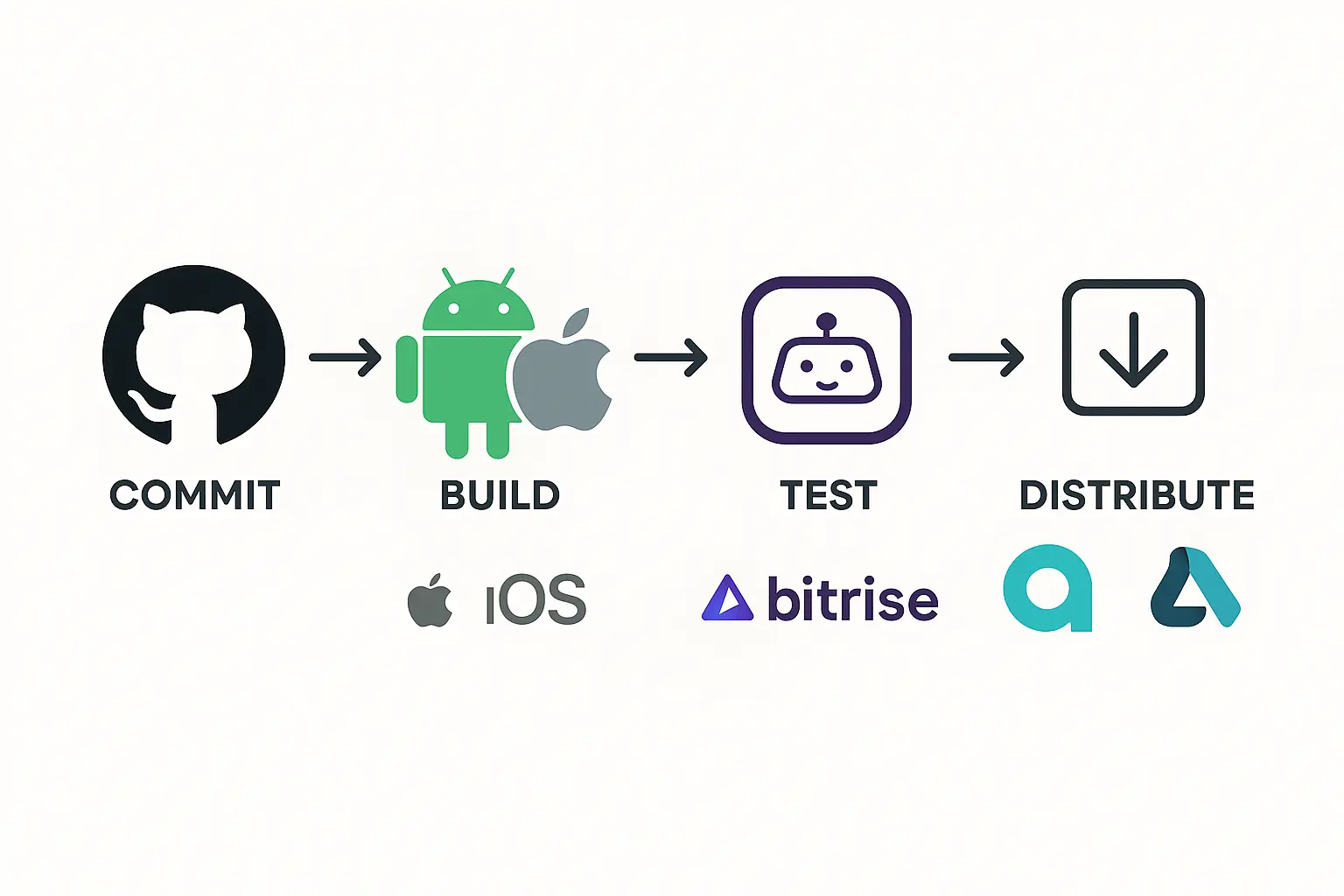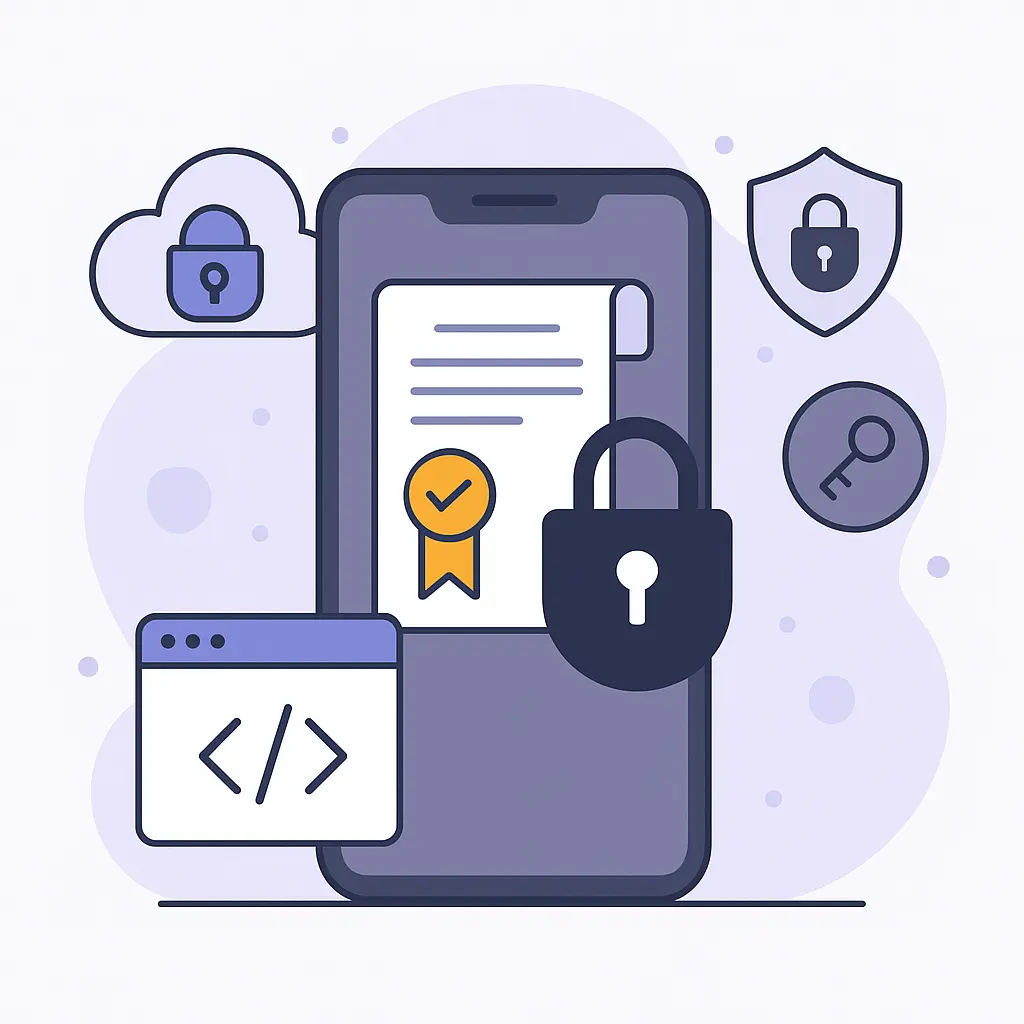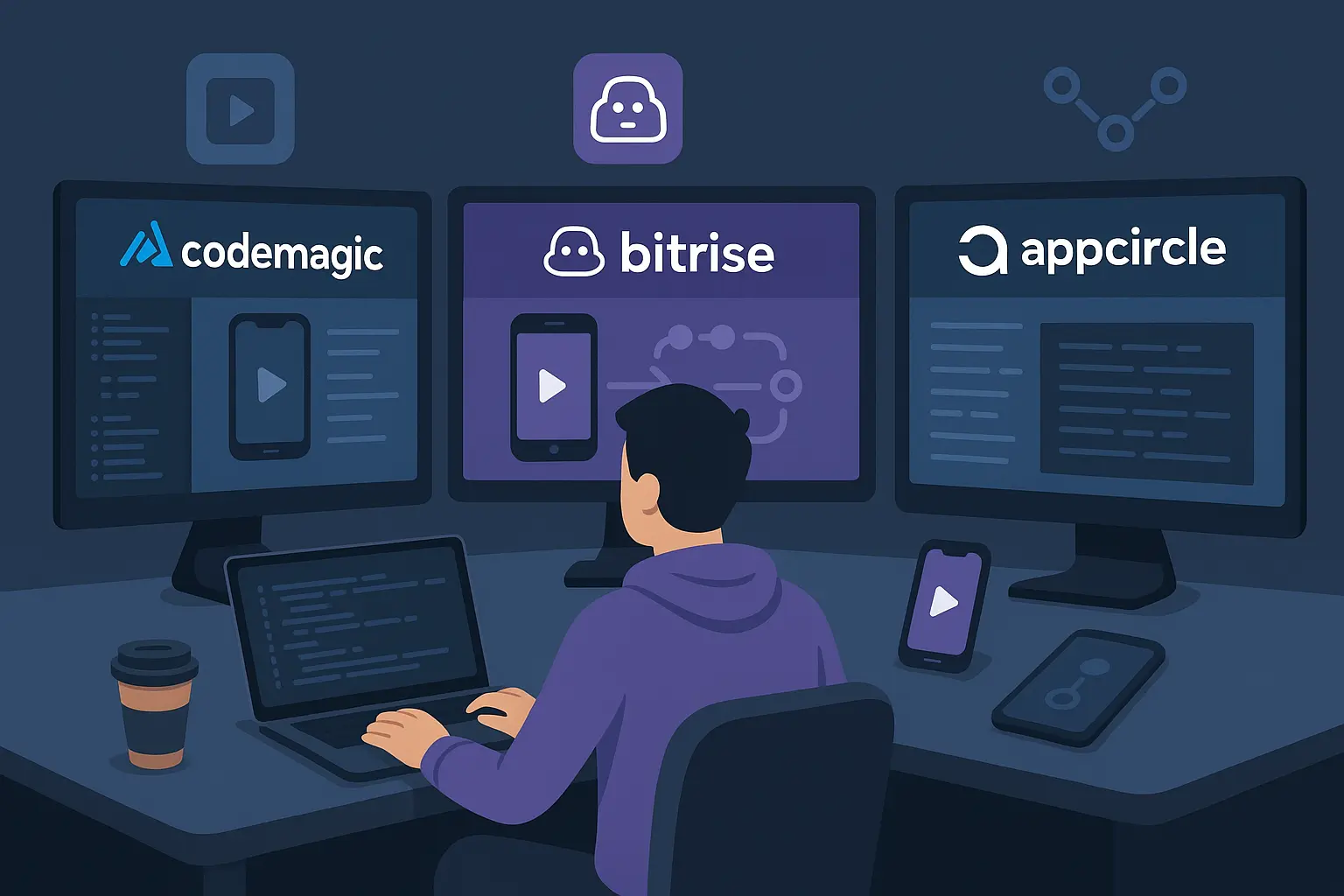Table of Contents
Introduction: Why Mobile CI/CD Matters in 2025
What is Mobile CI/CD? A Simple Explanation
Key Benefits of Implementing Mobile CI/CD
Tool Overview: Codemagic vs Bitrise vs Appcircle
Supported Platforms: Flutter, iOS, Android, React Native
Target Users: Indie Devs vs Enterprise Teams
Deployment Models: Cloud vs On-Premise vs Hybrid
Automation and Testing Pipelines
Pricing and Scalability in 2025
Pricing Models: Fixed vs Pay-as-you-go
Build Minutes and Concurrency Limits
Enterprise Plans and Overages
Cost Efficiency for High-Volume Teams
Case Study: How We Reduced Deployment Time by 73%
Conclusion: Choosing the Right CI/CD Tool for Your Needs
FAQ: Common Questions About Mobile CI/CD
Introduction: Why Mobile CI/CD Matters in 2025
In the competitive landscape of mobile development, continuous integration for mobile apps can make the difference between weekly and daily releases. Mobile DevOps practices have evolved significantly, with mobile app testing automation now essential for maintaining quality across different device types. Meanwhile, platforms like GitLab mobile CI/CD have raised the bar for what teams expect, especially those working with CI/CD for Flutter apps and other cross-platform frameworks.

This comparison of Codemagic, Bitrise, and Appcircle will help you navigate the key differences between these leading tools. We’ll examine their build capabilities, code signing features, pricing models, and security measures to help you determine which solution best fits your team’s needs. Whether you’re a solo developer or managing an enterprise mobile team, choosing the right CI/CD platform can significantly impact your development efficiency and release quality.
What is Mobile CI/CD? A Simple Explanation
Mobile CI/CD forms the backbone of modern app development workflows. CI/CD stands for continuous integration and continuous delivery, a practice that automates the process of getting code from developers’ machines to users’ devices.
A typical mobile CI/CD pipeline follows a structured workflow: detecting code changes, provisioning servers, fetching necessary tools, building the project, running local tests, executing instrumented tests on emulators, and uploading artifacts.
The benefits are substantial - automated testing at every development stage catches issues early, reduces broken builds, increases release confidence, improves team collaboration, and boosts productivity through automation of time-consuming tasks .
Furthermore, mobile CI/CD serves as the core enabler of DevOps methodology, breaking down silos between development and operations teams to create a unified workflow with shared ownership .
Key Benefits of Implementing Mobile CI/CD
Implementing mobile CI/CD delivers measurable advantages that directly impact your bottom line. Statistics show that teams can save up to 20% of development time through accelerated iteration cycles and automated workflows . This efficiency translates into substantial cost reductions for both development and maintenance activities.
Code quality improvements are equally impressive. Organizations report approximately 50% better code quality standards after implementing CI/CD practices . Moreover, these improvements lead to fewer post-release issues and higher user satisfaction.
Mobile CI/CD significantly enhances bug management through early detection systems. In one case study, a company identified and fixed more than 70 security issues prior to release across just 10 deployment cycles . This early intervention prevents costly fixes later in the development cycle when changes become exponentially more expensive.
Notably, the collaborative benefits extend beyond technical improvements. Real-time insights into build statuses, test results, and deployment progress create transparency that helps teams prioritize effectively . Consequently, developer burnout decreases while productivity increases .
The business impact remains undeniable. Mobile CI/CD enables faster time-to-market through automated testing and deployment mechanisms . Additionally, the streamlined release process ensures consistent quality across all app versions . For organizations facing fierce competition, this acceleration can provide the competitive edge needed to succeed in today’s rapidly evolving mobile landscape.
Tool Overview: Codemagic vs Bitrise vs Appcircle
Each mobile CI/CD platform offers distinct capabilities to address different development needs. Let’s examine how these three leading tools compare across key dimensions.
Supported Platforms: Flutter, iOS, Android, React Native
Codemagic supports a comprehensive range of frameworks beyond just mobile. Besides Flutter, React Native, native iOS, and Android, it extends to Ionic, Unity, web, macOS, and Linux. This makes it particularly valuable for cross-platform development teams.
Bitrise focuses specifically on mobile platforms with excellent support for iOS, Android, React Native, Flutter, Cordova, and Ionic. It’s designed as a fully-hosted mobile DevOps platform with specialized workflows for each framework.
Appcircle similarly supports major mobile platforms with specialized features for enterprise mobility needs.
Target Users: Indie Devs vs Enterprise Teams
Codemagic caters primarily to mobile-first developers with particular strength in Flutter projects. Its intuitive UI makes onboarding quick for independent developers.
Bitrise targets mobile-focused development teams seeking ready-to-use CI/CD solutions without infrastructure management hassles.
Appcircle distinguishes itself with an enterprise-first approach, offering enhanced team management and enterprise-specific functionalities that neither Codemagic nor Bitrise fully match.
Deployment Models: Cloud vs On-Premise vs Hybrid
Regarding deployment flexibility, Appcircle stands out by supporting self-hosted, private cloud, public cloud, and hybrid deployment options. Specifically, it supports Docker, Podman, Kubernetes, and OpenShift for local deployment.
Conversely, both Codemagic and Bitrise lack true self-hosted options. Bitrise only provides isolated cloud instances connected via site-to-site VPN, which doesn’t constitute a genuine on-premise solution.
To read more about tools you can refer to our blog Best Mobile Ci/Cd Tools Like Codemagic , Appcircle & Bitrise - Your 2025 Guide where we have done a deep down comparison between these tools .
Automation and Testing Pipelines
Creating efficient automation and testing pipelines is essential to handle over 3,000 daily builds and ensure a smooth release cycle. The core objective here is to maintain feature-driven development that emphasizes continuous improvement and rapid feedback.

Developing Feature-driven Pipelines
When your team focuses on feature-driven development, the CI/CD pipeline should:
Automatically build feature branches as soon as changes are committed
Run a suite of tests that include unit, integration, and UI tests
Provide instant feedback to developers via dashboards or email notifications
A good way to start is by mapping out each feature’s flow within the mobile app. Once that’s complete, you can create a dedicated pipeline stage for each feature. This way, a feature that interferes with the main branch can be isolated and tested independently.
Setting Up Automated Testing Pipelines
Testing pipelines must cover both traditional automated tests and advanced exploratory testing:
Set up independent test suites for critical components of your mobile app
Use parallel testing to reduce the time required to validate changes
Incorporate performance monitoring within your testing pipeline, allowing developers to adjust codebase optimizations quickly
Here is a step-by-step approach to building your automated testing pipeline:
Begin with unit tests that run on every commit
Follow with integration tests that simulate real data flows
Add UI tests that mimic user interactions on multiple screen resolutions and device types
Integrating these steps into your CI/CD pipeline reduces the likelihood of errors slipping into production. Moreover, the real-time feedback helps developers pinpoint and rectify issues almost immediately.
Pricing and Scalability in 2025
Pricing considerations for mobile CI/CD tools extend far beyond visible subscription costs. Indeed, the total cost of ownership includes both direct fees and hidden expenses like engineering time lost to maintenance.
Pricing Models: Fixed vs Pay-as-you-go
Codemagic offers a free tier with 500 build minutes, followed by flexible pay-as-you-go pricing based on actual usage . Alternatively, their annual plan starts at INR 25,229.75 monthly for unlimited build minutes . Bitrise employs a credits-based system with a free “Hobby” tier providing 300 monthly credits and 5 concurrent builds. Their paid plans begin at INR 2,953.32 monthly . Appcircle maintains a simpler structure with a free starter plan and customizable corporate options .
Build Minutes and Concurrency Limits
Each platform imposes specific resource constraints:
Codemagic: 120-minute build timeout per job
Bitrise: Credits convert to minutes based on machine type selected
CircleCI: 6,000 free build minutes with 30x concurrency
Enterprise Plans and Overages
Enterprise solutions offer enhanced capabilities including dedicated support, role-based access control, and custom deployment options . CircleCI’s Scale plan provides customizable options billed annually with optional 24/7 support .
⚡ 1-Click Deployments for 20+ Apps – Want the Same?
Tired of slow, manual deployments? We helped a hospital chain automate updates across 20+ Flutter apps with custom themes—all deployed in one go. Let us do the same for your product—with 30% off your first CI/CD integration this month. Faster launches, fewer errors, and total control—limited slots available!

Cost Efficiency for High-Volume Teams
For large teams, infrastructure optimizations yield substantial savings. Strategic solutions include streamlining build processes through efficient caching, implementing targeted testing approaches, optimizing artifact handling, and automating high-impact processes. Teams should evaluate mobile-specific challenges like macOS infrastructure costs and specialized virtual environments when calculating total ownership expenses .
Case Study: How We Reduced Deployment Time by 73%
During a recent enterprise healthcare project, we were tasked with delivering a modular hospital management application to a healthcare chain managing over 20+ hospitals. The challenge? Each hospital required its own branded Flutter app, with consistent functionality but a custom theme and branding unique to each location.
To meet this requirement, we developed a single Flutter codebase using 20+ app flavors, where theming and branding were dynamically applied via API at runtime. While this approach drastically simplified code maintenance, we encountered a major deployment bottleneck: pushing updates to all platforms (iOS, Android, and Windows) across 20+ app variants was time-consuming and error-prone.
The CI/CD Transformation
To streamline this process, we implemented an automated CI/CD pipeline using modern tools. Here's what we achieved:
Automated builds for all platforms (iOS, Android, Windows) using pipelines
One-click deployment for all 20+ flavored apps simultaneously
Integrated secure code signing and store distribution
All builds and logs tracked through a centralized dashboard
Role-based access control and audit logs for security and compliance
We successfully reduced deployment time by 73%, turning a multi-hour manual task into a fully automated process that completed in minutes—improving both developer productivity and release reliability.
Conclusion
Mobile CI/CD has evolved from a nice-to-have feature to an essential component of efficient app development. Teams that embrace these practices gain competitive advantages through faster releases, higher quality code, and reduced developer burnout. Whether you choose Codemagic, Bitrise, or Appcircle, implementing a robust mobile CI/CD pipeline will position your team for success in the increasingly demanding mobile development landscape.
We reviewed mobile CI/CD challenges and shared easy steps to fix problems while using practical tools and real examples, and learned how testing and automation lead to smoother builds Sometimes lessons overlap but the key points stand out. Boost your business with Custom Software Development | Tridev Technologies expert development team. Give it a try and see the difference today.
